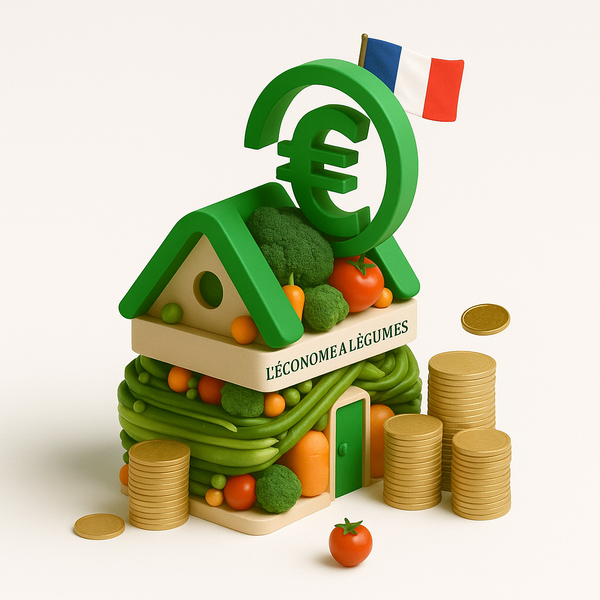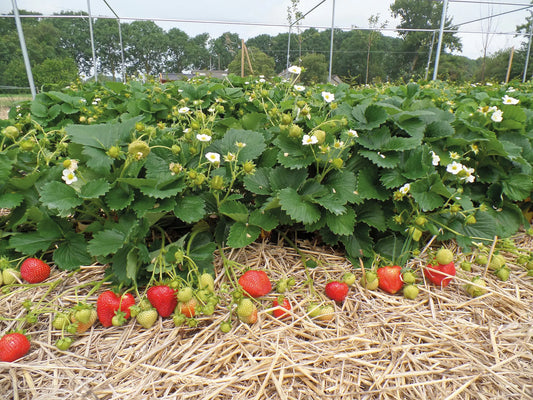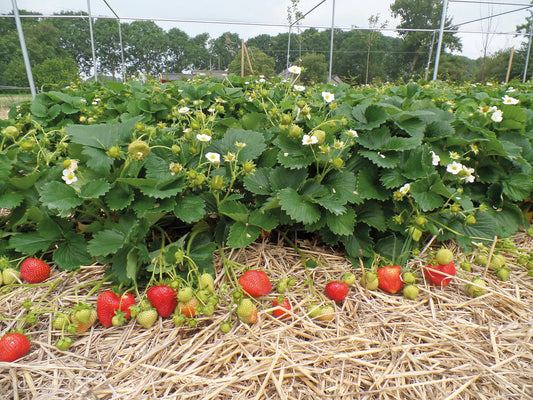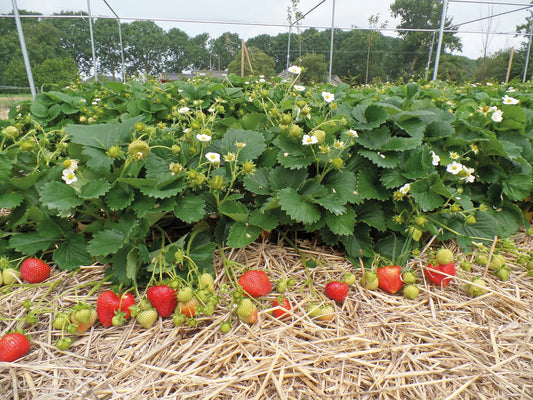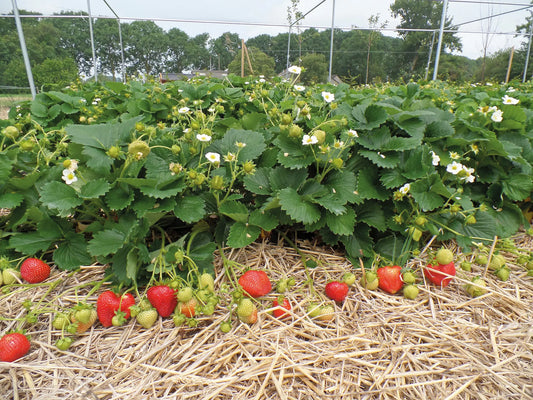Our Florentina Strawberry plants at producer prices
Buy now and get it delivered when you're ready to plant
-
Florentina Frigo A- Strawberry Plant
Regular price €0,30 EURRegular priceUnit price / per -
Florentina Frigo A Strawberry Plant
Regular price €0,31 EURRegular priceUnit price / per -
Florentina Frigo A+ Strawberry Plant
Regular price €0,34 EURRegular priceUnit price / per -
Florentina Frigo A++ Strawberry Plant
Regular price €0,40 EURRegular priceUnit price / per -
Florentina Mini-Tray Strawberry Plant
Regular price €0,63 EURRegular priceUnit price / per -
Florentina Tray Strawberry Plant
Regular price €0,69 EURRegular priceUnit price / per
Collapsible content
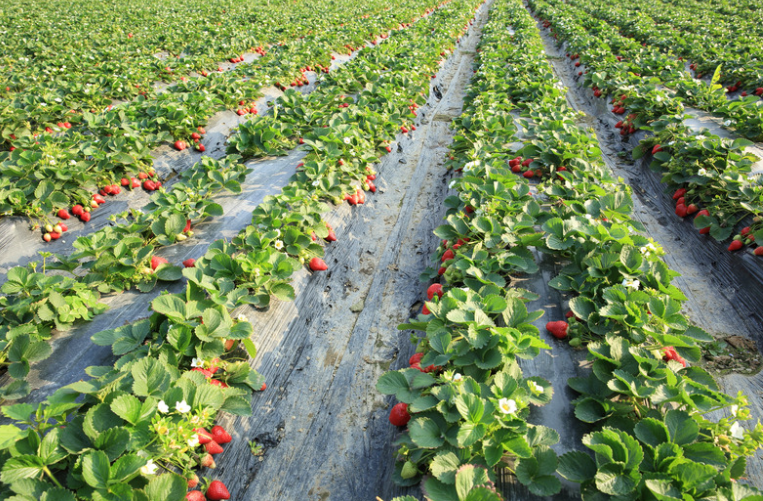
Strawberry Plant Buying Guide: What Type of Plants? For What Market Opportunity?
Which format should you choose: refrigerated, fresh, tray-plants, waiting bed, or plugs? Compare yields, costs, and harvest times at a glance.
Download the PDF guide (13 pages)
Why read this guide?
- Comparison tables: yield (300–600 g/plant), cost & labor.
- Reservation/delivery calendar for each format.
- Minimum order: 20 to 1,000 plants depending on the type.
- Full-field vs. above-ground case studies to maximize margin.
Overview of the 5 professional formats
Detailed comparison of formats
| Format | Yield (g/plant) |
Harvest time | Min. order | Average cost |
|---|---|---|---|---|
| Fridge | 250 – 400 | 120 days | 20 plants | 0.20 – 0.45 € |
| Costs | 280 – 420 | 140 days | 200 plants | 0.20 – 0.45 € |
| Tray plant | 400 – 600 | 90 days | 500 plants | 0.75 – 0.80 € |
| Waiting Bed | 300 – 500 | 105 days | 500 plants | 0.50 – 0.60 € |
| Motte | 230 – 350 | N+1 | 1,000 plants | 0.35 – 0.50 € |
Delivery schedule
| Plant type | Jan | Feb | Mar | Apr | May | Jul | Jul | Aug | Sep | Oct | Nov | Dec |
|---|---|---|---|---|---|---|---|---|---|---|---|---|
| Fridge | ||||||||||||
| Tray plants | ||||||||||||
| Waiting Bed | ||||||||||||
| Motte | ||||||||||||
| Costs |
Which format for which scenario?
Full field controlled budget
Fridge or Fresh : cost 2 x lower than tray plants, planting flexibility.
Above ground in greenhouse
Tray-plants : harvest 90 days after planting, uniform size, reduced labor.
Late planting
Mottes : planting July–August, rapid recovery, harvest the following year.
Ready to plan your plantings?
Download the complete guide Request a quoteFrequently Asked Questions
Is the guide free?
Yes, no fees or obligation to purchase.
How to download it?
Click the button “Download the guide” ; the PDF opens immediately.
Can I request a personalized quote?
Of course: write to us at contact@fraisiverse.com and an agronomist will respond to you within 24 hours.
Choosing the right strawberry varieties for your plot
Extend your harvest season by up to 5.5 months with our "early + season + everbearing" method. Compare 78 cultivars, sizes, and markets.
Download the PDF guide (17 pages)
4 axes to decide quickly
- Harvest Window : Early, Seasonal, or Everbearing? Combine them for 5.5 months .
- Commercial outlet : direct sales, long circuit, processing or freezing.
- Type of plants : fridge, fresh, root ball, tray plants… adapt your investments and your schedule.
- Growing conditions : open field, soilless, greenhouse; target consistent yield and size.
Axis 1: Select your harvest window
Example of recommended mix:
- Ciflorette (early) → Rubis des Jardins (season) → Charlotte (remontant).
- 5.5 months of continuous production, ideal for direct sales.
Axis 2: Sell at the right market
Direct sales
Ciflorette, Charlotte, Mara des Bois: premium taste sought after by consumers.
Long circuit / GMS
Magnum, Clery, Dream: uniform size, 95% class 1 fruit.
Transformation
Darselect, Mara des Bois – high sugar content and stable aroma.
Freezing
Honeoye, Belrubi – firm flesh, keeps well in the cold.
Axis 3: Choose the right type of plants
| Kind | Reservation | Delivery | Highlights |
|---|---|---|---|
| Fridge | All year round | Dec. → Aug. | Flexibility & price |
| Tray plants | Feb. → June | Nov. → Apr. | Above ground, harvest 90 days after planting |
| Motte | Sep. → May | Jul. → Sep. | Ideal for open fields, harvest N+1 |
| Costs | Feb. → Aug. | Sep. → Nov. | Young plants, rapid recovery |
Axis 4: Optimize your technical constraints
Tray plants guarantee +25% yield and simplified harvesting above ground; ideal for mechanizing your production and ensuring consistent size.
Frequently Asked Questions
Is the guide really free?
Yes, with no cost or obligation to purchase.
How to download it?
Just click the button “Download the guide” at the top of the page; the PDF opens immediately.
Can I request a personalized quote?
Of course: contact us via our contact page .
When to plant? When to harvest?
Do you want to start a strawberry farm but don't know when to reserve your plants, when to plant them or even harvest them?
Because we love 🍓 (with just a little sugar), we're going to do the work for you. On this page, you'll find the growing steps for each type of strawberry plant. When to order? What is the delivery period? When to plant? And finally, when to harvest?
Production Calendar - Frigo Strawberry Plants
| Production Calendar - Frigo Strawberry Plants | ||||||||||||||||||||||||
|---|---|---|---|---|---|---|---|---|---|---|---|---|---|---|---|---|---|---|---|---|---|---|---|---|
| Jan | Feb | Mar | Apr | May | Jun | Jul | Aug | Sep | Oct | Nov | Dec | |||||||||||||
| Reservation | ||||||||||||||||||||||||
| Deliverable | ||||||||||||||||||||||||
| Recommended planting | ||||||||||||||||||||||||
| Harvest | ||||||||||||||||||||||||
Production Calendar - Fresh Bare-Root Strawberry Plants
| Production Calendar - Bare Root Strawberry Plants | ||||||||||||||||||||||||
|---|---|---|---|---|---|---|---|---|---|---|---|---|---|---|---|---|---|---|---|---|---|---|---|---|
| Jan | Feb | Mar | Apr | May | Jun | Jul | Aug | Sep | Oct | Nov | Dec | |||||||||||||
| Reservation | ||||||||||||||||||||||||
| Deliverable | ||||||||||||||||||||||||
| Recommended planting | ||||||||||||||||||||||||
| Harvest | ||||||||||||||||||||||||
Production Calendar - Strawberry Plants Plugs
| Production Calendar - Strawberry Plants Motte | ||||||||||||||||||||||||
|---|---|---|---|---|---|---|---|---|---|---|---|---|---|---|---|---|---|---|---|---|---|---|---|---|
| Jan | Feb | Mar | Apr | May | Jun | Jul | Aug | Sep | Oct | Nov | Dec | |||||||||||||
| Reservation | ||||||||||||||||||||||||
| Deliverable | ||||||||||||||||||||||||
| Recommended planting | ||||||||||||||||||||||||
| Harvest | ||||||||||||||||||||||||
Production Calendar - Strawberry Plant Tray
| Production Calendar - Strawberry Plants Motte | ||||||||||||||||||||||||
|---|---|---|---|---|---|---|---|---|---|---|---|---|---|---|---|---|---|---|---|---|---|---|---|---|
| Jan | Feb | Mar | Apr | May | Jun | Jul | Aug | Sep | Oct | Nov | Dec | |||||||||||||
| Reservation | ||||||||||||||||||||||||
| Deliverable | ||||||||||||||||||||||||
| Recommended planting | ||||||||||||||||||||||||
| Harvest | ||||||||||||||||||||||||
Our Growing Guides by Plant Type / Our Growing Tips
Our online advisor: Fraisibot
Our technical itineraries by type of strawberry plant:
Technical Itinerary for Growing Strawberries from Frigo Plants
Technical Itinerary for Growing Strawberries from Plug/Pod Plants
Technical Instructions for Growing Strawberries from Tray or Mini Tray Plants
Technical Guide for Growing Strawberries from Bare-Root Fresh Strawberry Plants
Technical Instructions for Growing Strawberries from Waiting Bed Plants
All our growing tips for planting strawberries:
Strawberry Plants: Soil Preparation and Planting
Soil preparation for strawberry growing, planting techniques, and optimizing strawberry yield.
Best Practices for Irrigation and Fertilization of Strawberry Plants
Efficient irrigation systems, frequency and quantity of watering, types of fertilizers and application times, signs of nutritional deficiencies, growing strawberries in substrate, protection against frost and diseases.
Protection and Prevention of Strawberry Diseases and Pests
The main diseases and pests affecting strawberries, as well as effective methods for their prevention and treatment, including biological control and the use of resistant varieties. It provides practical advice for maintaining healthy and productive strawberry crops.
Succeeding in Strawberry Farming: Costs, Business Strategy and Subsidies
Growing strawberries requires significant initial and ongoing costs, but with effective marketing strategies and sustainable practices, growers can maximize their profits while contributing positively to the environment. Grants and financial aid are available to support necessary investments and encourage environmentally friendly farming practices.
Maximizing Strawberry Harvest and Storage: A Practical Guide
How to determine the optimal time to harvest strawberries, best practices for minimizing fruit damage during picking, and effective methods for storing and managing unsold strawberries to avoid losses and maximize profitability. It offers practical tips for extending the shelf life of strawberries, including refrigeration, freezing, and dehydration.
Strawberry Growing: Why Stagger Production? Early, Seasonal, Late? How to Choose?
Staggering strawberry production allows for harvests to be spread throughout the season, ensuring optimal fruit quality and increased profitability. Learn about recommended varieties for early, mid-season, and late-season production, as well as best practices for harvesting and storage.
-
Delivery from 10 plants to France, Switzerland and Europe
Delivery methodWe deliver anywhere in France as quickly as possible. Cost/quality balance is our priority.
-
Strawberry Plant Wholesale Supplier
About UsWe work with dozens of producers to offer you the best prices.
-
Quality Strawberry Plants
Strawberry Technical ItinerariesOur producers are selected for their reliability and the quality of their products.
-
Collection: Our Florentina Strawberry plants at producer prices
Technical sheet of the Florentina strawberry variety
- Remontant: Remontante
- Earliness: Remontante
- Harvest period: All year round depending on floral induction and planting period by successive period (remontant) and type of plants
- Shape, texture, appearance of the Fruit: Conical-round
- Fruit color: Intense red
- Taste characteristics: Good taste quality
- Fruit Size: Good taste quality
- Disease resistance: Keeps well if not picked too ripe. Do not plant too deep. Tolerant to Phytophtora. Resistant to Botrytis.
- Performance, management and marketing: Suitable for all types of sales niches. Very high performance
- Recommended commercial use / marketing channel: Direct sales, Wholesale, Processing
Order your professional strawberry plants
Fraisiverse, a specialist wholesale supplier of strawberry plants , offers you the professional Florentina variety, ideal for regular, high-quality production. Buying your strawberry plants guarantees you a high yield and impeccable visual quality, suitable for demanding markets. Benefit from producer prices , professional quality guaranteed by specialized nurseries, as well as dedicated technical support and personalized advice to optimize your plantings. Our services include fast and careful delivery throughout France and decreasing prices for your volume orders. Florentina seduces with its varietal resistance, its firmness and its consistent yield throughout the season. Order your plants now and reserve your supplies now to guarantee regular production. Take advantage of our producer prices and secure your season with a variety recognized by professionals for its performance and post-harvest stability. Request a free quote to plan your deliveries.
Agronomic characteristics and varietal phenology
The Florentina strawberry is an early everbearing variety , a major asset allowing continuous production over a long period of the year. Its flowering, in a temperate climate, begins in the last ten days of May, around weeks 21 to 22 of the calendar. The first main harvest then occurs around mid-June, marking the start of a staggered fruiting cycle. This "everbearing" characteristic gives growers the flexibility to supply fruit in several waves, from late spring to early autumn, and potentially until early October if conditions allow.
Morphology and commercial qualities of the fruit
Florentina fruits are distinguished by a very attractive visual appearance, essential for marketing. Their external color is an intense red , sometimes described as burgundy red, enhanced by a remarkable shine. The skin, thin but dense, provides good resistance to handling and transport. Inside, the flesh is bright red, uniform throughout the fruit section, without a marked white core , thus guaranteeing an impeccable presentation when cut. The shape of the strawberries is conical to conical-round, regular, and free from major deformations. To the touch, the surface may be slightly rough due to the protruding achenes, a detail that in no way detracts from its brilliance. The size of the fruits is generous, with an average weight of about 30 grams during the first wave of harvesting. This weight can even reach 40 to 50 grams during the second wave, although it can vary between 15 and 30 grams at the end of the season depending on growing conditions.
Texture and organoleptic profile
As for the texture, Florentina offers a very firm and not very juicy flesh , which provides a marked crunchiness when tasting. This firmness translates into a resistance to penetration generally between 0.5 and 0.7 kg/cm² for a strawberry of this professional quality. The dense skin does not wrinkle easily when picked, contributing to excellent transportability. The taste profile is very appreciated, combining a very sweet taste with a refreshing note of acidity, all tinged with aromas reminiscent of wild strawberry and pineapple . To preserve their quality and impeccable appearance, it is crucial not to pick Florentina fruits when overripe.
Intensive cultivation protocols and nutritional management
Florentina strawberry cultivation is designed for professional production, where optimizing cultivation practices is essential to fully exploit its potential. As a remontant variety, Florentina is most likely suited to high-density soilless systems , whether gutters or substrate bags. This method, increasingly widespread in France and representing around 40% of production, allows better control of environmental factors (climate, watering, nutrition) and facilitates harvesting while limiting the risk of disease.
Planting densities and substrate volumes
In soilless cultivation, a typical planting density is between 12 and 14 plants per square meter , or 8 to 14 plants per linear meter depending on the container, with a substrate volume of 1 to 1.25 liters per plant . For optimal nutrition and without the risk of salinity, the electrical conductivity (EC) of the nutrient solution at application must be maintained between 1.0 and 2.2 mS/cm , with a pH between 5.5 and 6.0. Bi-monthly monitoring of the EC is imperative, as exceeding 2.2 mS/cm can lead to reduced size, organoleptic defects and a drop in yield.
Fruiting cycle and nutritional management
The Florentina variety produces generative buds every 5 to 6 weeks , ensuring regular fruiting throughout the production period. This requires continuous and adapted nutritional management to support this productivity. It is crucial to follow the recommendations for fertilization, irrigation and planting density to obtain optimal results. Regularity of size over the duration of the harvest also depends on rigorous control of nutrition and irrigation.
Productive potential and harvest planning
The Florentina strawberry plant is renowned for its high yield , making it a major asset for professional growers. Under optimal growing conditions, an adult Florentina plant can produce between 1.5 and 2.5 kilograms of fruit per season . In terms of surface area, you can aim for up to 1.5 kg/m² under optimized professional conditions, which represents significant productivity.
Production window and time distribution
As an everbearing variety, its production is not concentrated in a short period but spread over several months. After harvesting begins around mid-June (week 24), the majority of production, around 70% of the total volume , is concentrated in a period of 8 to 10 weeks. More specifically for Florentina, this window extends approximately from mid-June to mid-August (weeks 24 to 33) . During this period, the yield reaches its maximum, with peak production often observed around weeks 27 to 29 , depending on growing conditions and planting density. This spread out production is a competitive advantage for professionals seeking to maintain a regular supply of fresh strawberries throughout the summer season.
Health program and tolerance to bioaggressors
The Florentina strawberry plant, although vigorous and productive, requires special attention in terms of health management. This variety is considered tolerant to Phytophthora , a common root disease that can cause significant damage. However, it is susceptible to Botrytis (grey mold), a fungal disease that affects fruit, as well as to fungal diseases and pests more generally.
Marketable fruit rate and quality management
It is important to note that Florentina has virtually no sterile flowers , which contributes to a high proportion of marketable fruit from the packaging stage. However, its susceptibility to fungal diseases and pests can impact the rate of first-class fruit if health management is not rigorous. An episode of high pest or fungal pressure is likely to increase the proportion of downgraded fruit. To obtain optimal results, with a rate of Class I fruit of 80% to 90% and a uniform size, it is imperative to follow strict recommendations regarding fertilization, planting density and phytosanitary management.
Economic performance and commercial positioning
The Florentina variety is primarily intended for fresh consumption , a market segment in which it excels thanks to its visual and taste characteristics. Its continuous production throughout the season is a major asset for producers wishing to regularly supply fresh markets, short supply chains or direct sales. The firmness of its fruits and their attractive appearance make it a sought-after product for immediate consumption.
Commercial performance and waste rate
In terms of profitability, Florentina offers a high rate of first-class fruit . Varietal trials indicate a commercial yield of 885 grams per plant out of a total of 984 grams, which represents approximately 90% of marketable Class I fruit . The waste rate, including malformed or damaged fruit, is therefore around 10%. Uniformity of size is also a strong point: at peak production, the majority of fruits are between 18 and 20 grams , a stable and regular size even over the waves of harvest, thus facilitating calibration and packaging.
Inadequacy for industrial transformation
On the other hand, Florentina is not primarily used for industrial processing (jam, freezing, agro-industry). Manufacturers often favor non-everbearing varieties with grouped production and very high yields for mass processing. The texture and flavor profile of Florentina are optimized for fresh consumption and not for cooking or long-term freezing. Its industrial destination therefore remains secondary, and it does not present any particular advantage compared to other varieties specifically selected for these uses.
Field feedback from specialist producers
Feedback and professional opinions regarding the Florentina strawberry plant converge towards a consensus: it is a variety that combines productivity and remarkable organoleptic qualities for the fresh market. Its everbearing nature is a frequently highlighted asset, as it allows farms to offer a continuous supply of quality strawberries over a long period, thus meeting growing consumer demand. The uniformity of size and the bright visual appearance of the fruits are highly appreciated criteria, facilitating their marketing in punnets or loose on the shelves.
Professionals value the firmness of the fruit , which gives it excellent post-harvest stability, essential for transport and marketing in both short and long supply chains. Although no direct producer quotes have been specifically provided here, technical descriptions emphasize these qualities, which meet the expectations of a demanding clientele in terms of quality, presentation, and flavor. Its productivity and the virtual absence of sterile fruits are also elements that reinforce farmers' confidence in the profitability of this variety.
To summarize: Our Florentina strawberry plants
At Fraisiverse , we provide you with Florentina strawberry plants selected to meet the requirements of professionals. As a specialist wholesale supplier of strawberry plants , we guarantee consistent quality and certified nursery origin. The Florentina is distinguished by its everbearing nature, its ability to produce beautiful, bright red fruits over several months, and a yield of up to 2.5 kg per plant in optimized conditions. Choosing this variety means Buy Florentina strawberry plants adapted to soilless systems, with controlled density and proven tolerance to Phytophthora. Thanks to our expertise as a specialist wholesale supplier of strawberry plants , we support you with precise technical advice, to maintain a uniform size and a Class I fruit rate greater than 85%. With Buy Florentina strawberry plants , you benefit from a product appreciated for its firmness, transportability and unique taste profile. Our commitments as a specialist wholesale supplier of strawberry plants include reliable logistics and availability tailored to your growing schedule. Finally, purchasing Florentina strawberry plants from us means choosing a cost-effective, efficient, and recognized solution on the fresh produce market.
Fraisiverse - Your supplier of quality strawberry plants. Organic or conventional. Delivery throughout France. Wide range of strawberry plants: Tray Strawberry Plants, Motte Strawberry Plants, Frigo Strawberry Plants, Waiting Bed Strawberry Plants. Strawberry plants for professional and private strawberry growers
